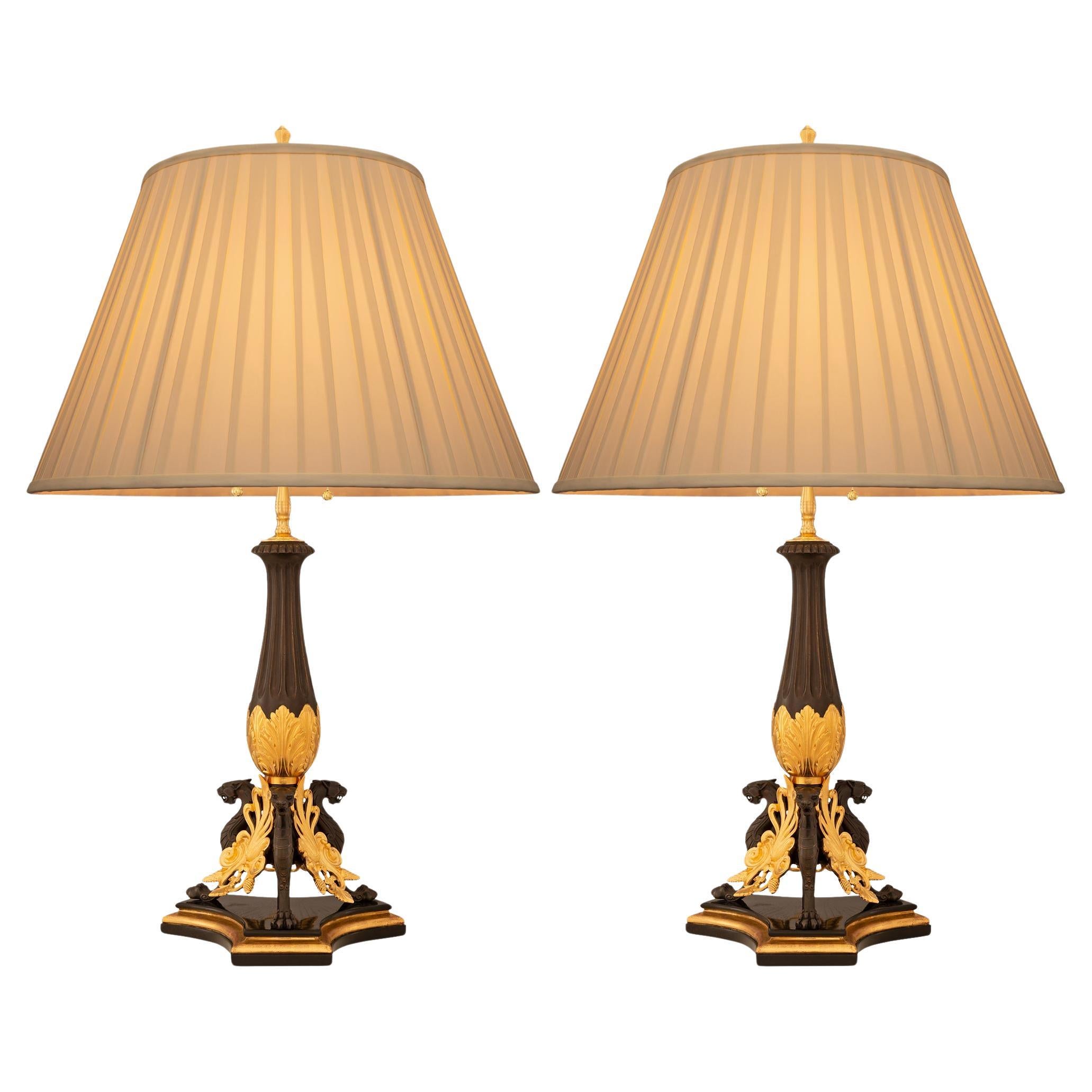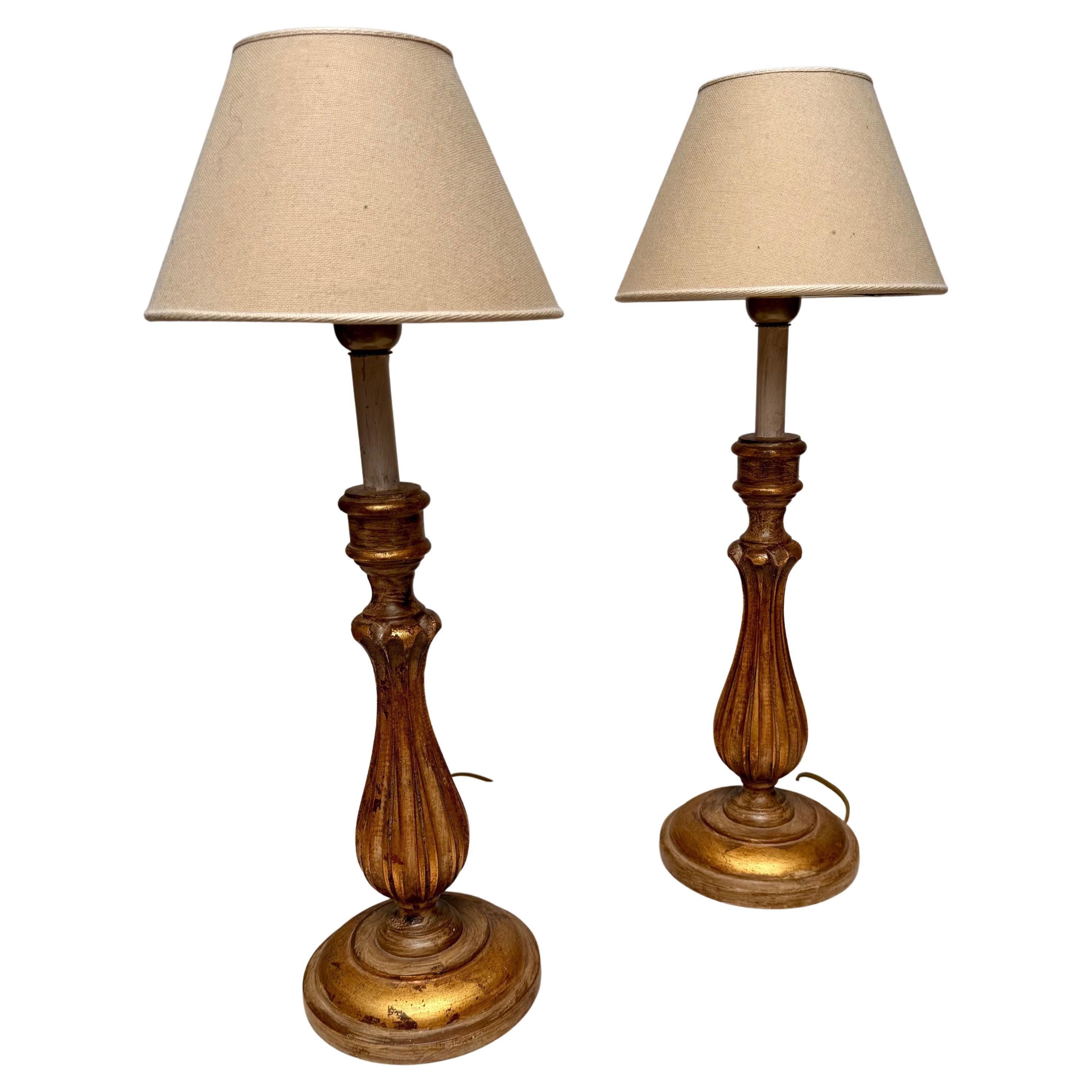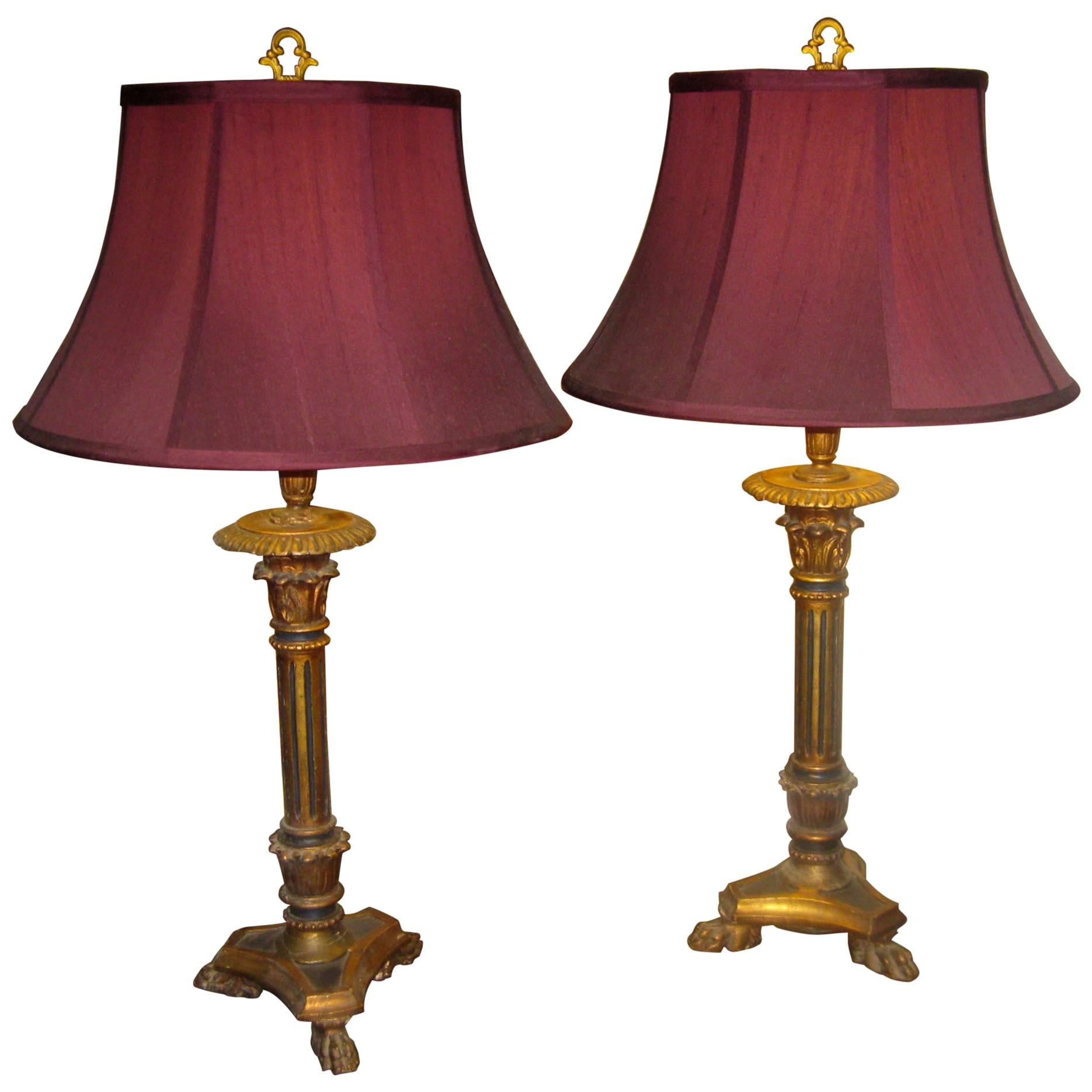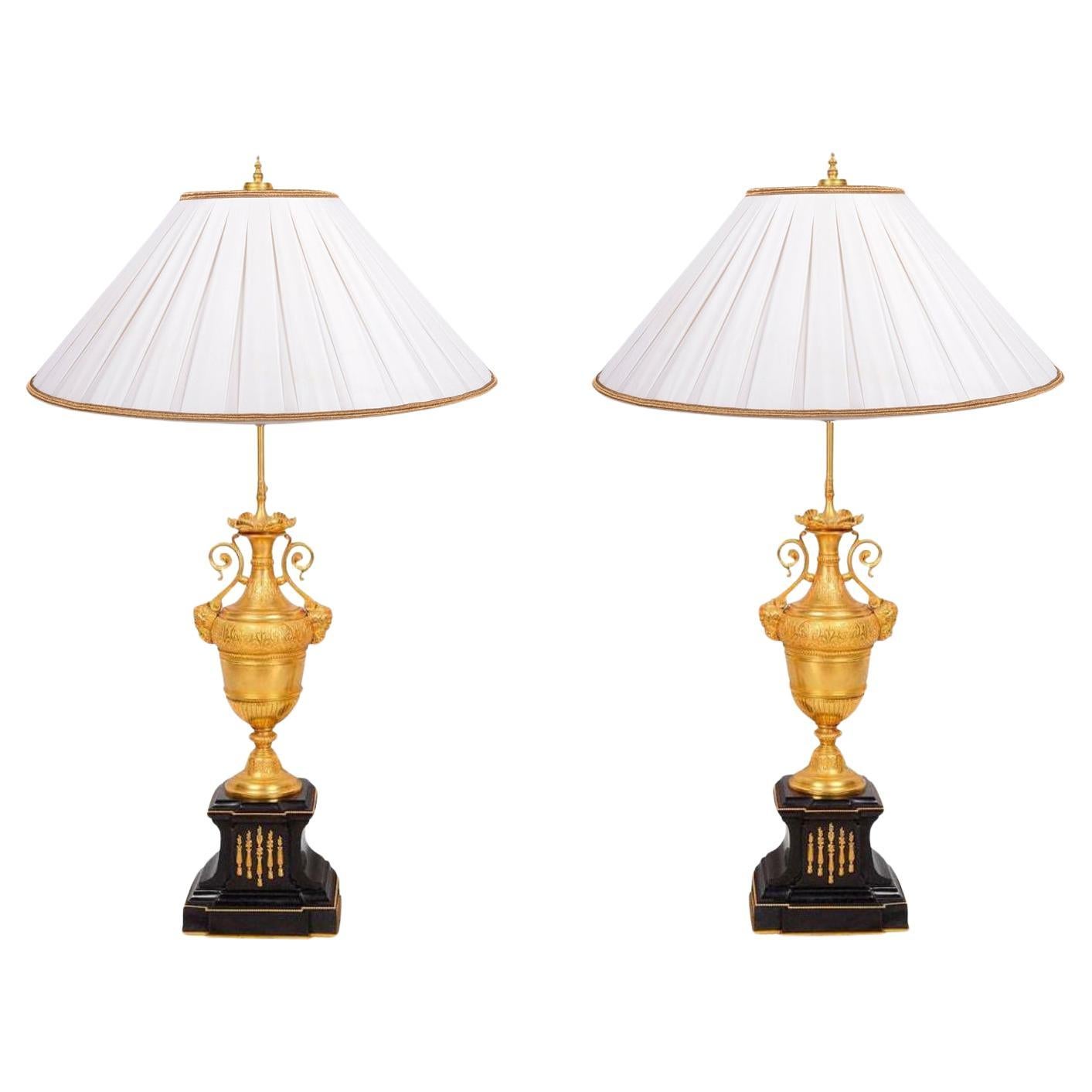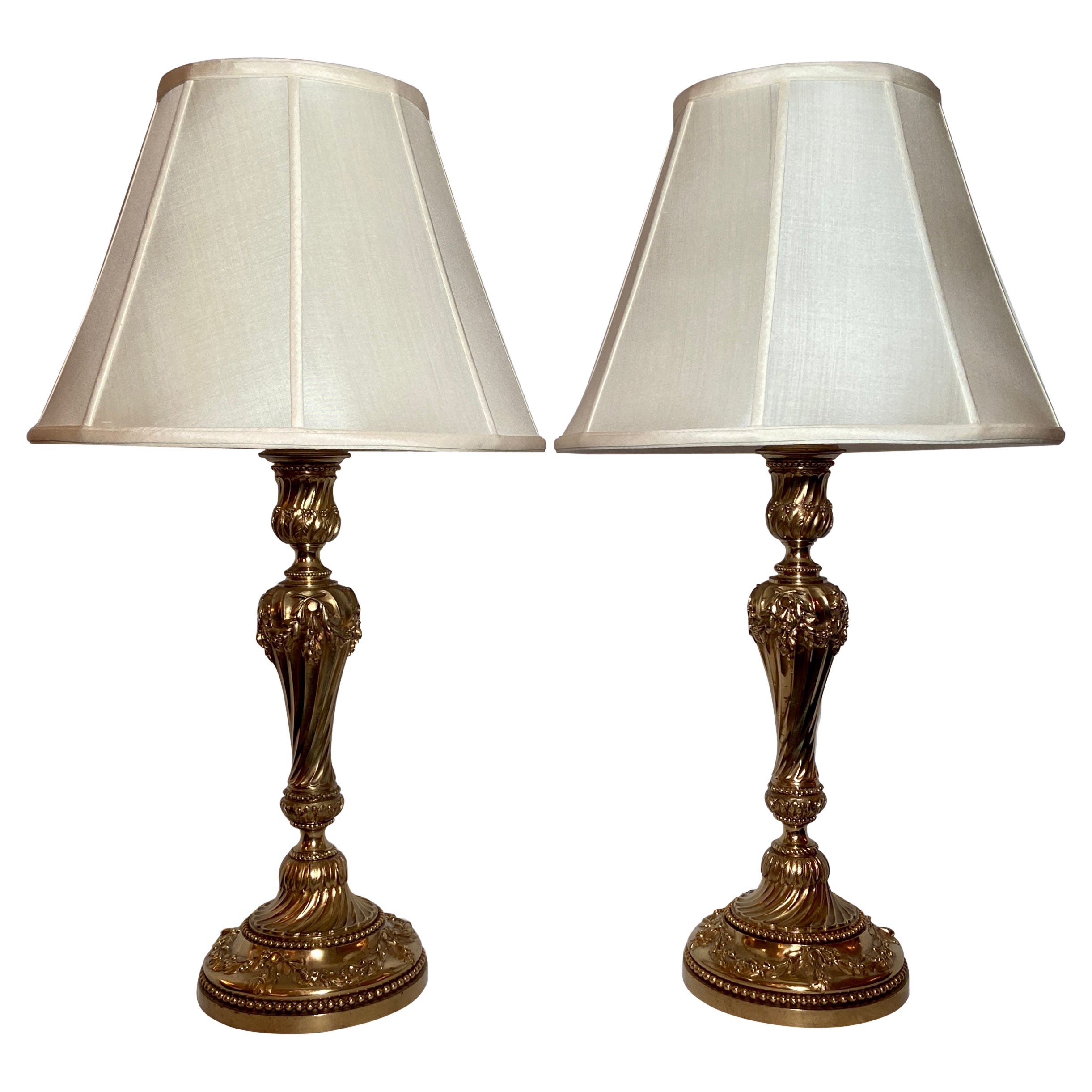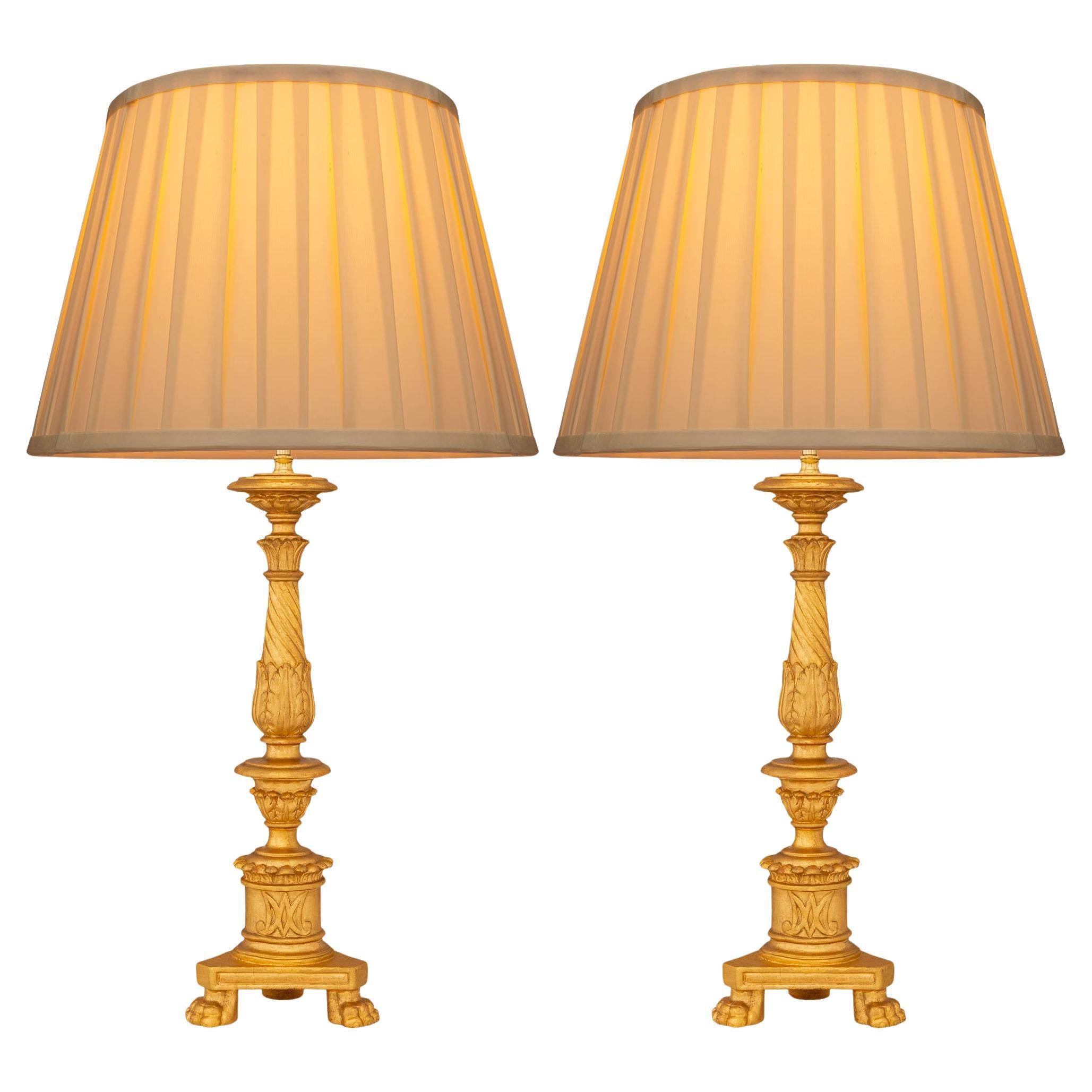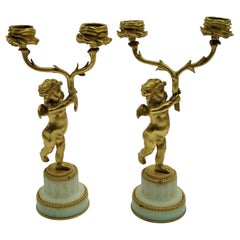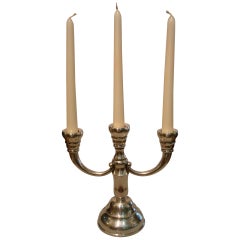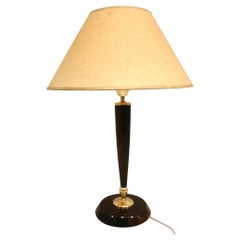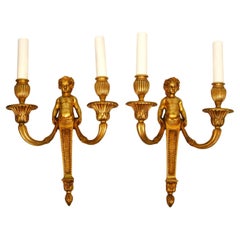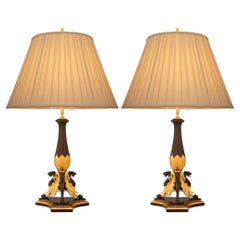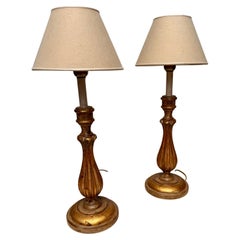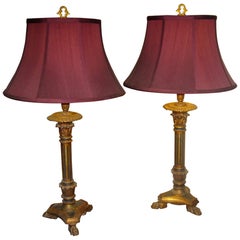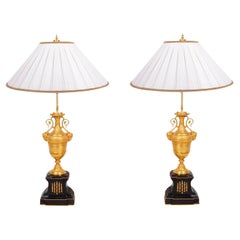Items Similar to Pair of Giltwood and Brass Table Lamps, Wiener Secession
Want more images or videos?
Request additional images or videos from the seller
1 of 10
Pair of Giltwood and Brass Table Lamps, Wiener Secession
$2,399.20per set
$4,500per set46% Off
£1,802.35per set
£3,380.53per set46% Off
€2,078.40per set
€3,898.30per set46% Off
CA$3,329.20per set
CA$6,244.34per set46% Off
A$3,699.48per set
A$6,938.84per set46% Off
CHF 1,938.57per set
CHF 3,636.02per set46% Off
MX$45,367.51per set
MX$85,092.45per set46% Off
NOK 24,725.28per set
NOK 46,375.36per set46% Off
SEK 23,260.64per set
SEK 43,628.24per set46% Off
DKK 15,512.28per set
DKK 29,095.23per set46% Off
Shipping
Retrieving quote...The 1stDibs Promise:
Authenticity Guarantee,
Money-Back Guarantee,
24-Hour Cancellation
About the Item
Very nice pair of wooden gilt and brass table lamps. Very rare style. They have the style of the Vienna Secession, specially the work of Dagobert Peche. Shades are not original. The electrical cables will be changed for new ones before shipping.
The Vienna Secession (German: Wiener Secession; also known as the union of Austrian artists, or Vereinigung Bildender Künstler Österreichs) was formed in 1897 by a group of Austrian artists who had resigned from the association of Austrian artists, housed in the Vienna Künstlerhaus. This movement included painters, sculptors and architects. The first president of the secession was Gustav Klimt, and Rudolf von Alt was made honorary president. Its official magazine was called Ver Sacrum.
Dagobert Peche (1887-1923), Wiener Werkstätte, He joined the Wiener Werkstatte in 1914 and exhibited at Deutscher Werkbund exhibition in Cologne and then became a co-director thereof in 1916. Whilst there in the early 1920s he introduced a 'Spiky Baroque' style inspired by Folk Art, and using flowers, animals and human figures as decorative motifs.
We have specialized in the sale of Art Deco and Art Nouveau and Vintage styles since 1995. If you have any questions we are at your disposal. Pushing the button that reads 'View All From Seller'. And you can see more objects to the style for sale. Why are there so many antiques in Argentina?
In the 1880 – 1940 there was a grate wave of immigration encouraged by the periods of war that were taking place. 1st World War took place between 1914 and 1918 2nd World War took place between 1939 and 1945 The immigrants options were New York or Buenos Aires. Tickets were cheap and in Buenos Aires they were welcomed with open arms, as it was a country where everything was still to be done. Argentina was the country of new opportunities, labour was needed and religious freedom was assured, in many cases the of the family travel first until they were settled and then the rest of the family members join them. In the immigrant museum “Ellis Island Immigrant Building” in New York you can se the promotional posters of the boats that would take them to a new life. Between the years 1895 and 1896, Argentina had the highest DGP (gross domestic product) per capita in the world according to the Maddison Historical Statistics index, this situation arose due to the large amount of food being exported to European countries, which were at war. The Argentinean ships left the port of Buenos Aires with food, but they returned with furniture, clothes and construction elements, (it´s common to see this the old buildings of the historic neighbourhood of San Telmo, the beams with the inscription “Made in England)”, as well as many markets that were built in Buenos Aires, such us the San Telmo Market, whose structure was brought by ship and afterwards assembled in 900 Defensa Street. With the great influence of European immigrants living in the country, the children of the upper classes travelled to study in France, resulting in the inauguration of “La Maison Argentinienne”, on 27th of June 1928, in the international city of Paris, which hosted many Argentinians that were studying in Frace. It´s the fourth house to be built after France, Canada and Belgium, being the first Spanish-speaking one. Still in place today (17 Bd Jourdan, 75014, Paris, France). Many of the children of these wealthy families who attended international art exhibitions, museums and art courses abroad, took a keen interest in the European style. This is why Buenos Aires was at the time referred as “The Paris of South America”. Between the years 1890 and 1920 more than a hundred Palaces were built on Alvear Avenue the most exclusive avenue in Buenos Aires. Today some of these palaces have been transformed into museums, hotels and embassies. In the year 1936, the Kavanagh building was inaugurated, it was the tallest reinforced concrete building in South America. During 1994 the American Society of Civil Engineers distinguished it as an “international engineering milestone”, and it´s now considered a World Heritage of Modern Architecture. At the time was common to hire foreign architects such as Le Corbusier, who visited Buenos Aires/Argentina in 1929 and in 1948 he drew up the blueprints for a house built in La Plata City (which was declared a World Heritage Site). In 1947, the Hungarian architect Marcelo Breuer designed “Parador Ariston” in the seaside city of Mar del Plata. After an Argentinean student at Harvard University convinced him to come to Argentina. He worked on an urban development project in the Casa Amarilla, area of La Boca. The Ukrainian architect, Vladimiro Acosta, arrives in Argentina in 1928 and worked as an architect until que moved to Brazil. Antonio Bonet, a Spanish architect who worked with Le Corbusier in Paris, arrives in Argentina in 1937, where he carried out several architectural works and in 1938 designs the well-known BFK chair. Andres Kálnay, of Hungarian origin, made around 120 architectural masterpieces, among which the former Munich brewery stands out, he even made the furniture’s design. The German architect, Walter Gropius, director of the Bauhaus, lived in Argentina, where he wrote articles for “Sur” magazine and founded in Buenos Aires, an architectural firm with Franz Möller, who was also an architect, where he built two houses. At the same time several famous designers decided to immigrate to Argentina, among them we can find the well-known French designer, Jean-Michel Frank, who arrived in the country in 1940 and also worked for the Rockefeller family. Special pieces were made, which were sold exclusively in the country, such as the well-known German company “WMF”, who sold their products by catalogue, which were chosen by the ladies of high society in the list of wedding gifts, as well as the pieces designed by Christofle. The Swiss sculptor Alberto Giacometti, made special pieces for Argentinean mansions. In 1904 the first Jansen branch outside Paris was established in Buenos Aires, as the Argentinean clientele demanded a large amount of furniture, from the end of the 19th century to the mid-20th century. In 1970, the brand Rigolleau Argentina made pieces authorised by Lalique. The brands Maple and Thompson also set up shop in the country. The French plastic artist, Marcel Duchamp moved to Argentina in 1918-1919. Glass signed Gallé, Charder, Leverre, Schneider, Muller and other French firms. They were bought in flower shops and were given to ladies with beautiful floral arrangements. Some furniture manufacturers travelled to international fairs and bough the patterns to produce the furniture in Argentina, such as the furniture firm Englander and Bonta, who bought the patterns in Italy. It is worth mentioning that in Argentina we have the largest community of Italians outside of Italy, as it is estimated that 70 percent of the inhabitants have at least one Italian descendant, followed by Spanish immigrants. The most Important furniture stores in Argentina: Comte is founded in 1934 (under the direct management of Jean Michel Frank in 1940). Nordiska (Swedish company established in 1934). Churba in 1960, a company that brought foreign designers to present their furniture in the country: Denmark: (Arne Jacobsen, Finn Juhl, Bender Madsen, Ejner Larsen, Poul Kjaerholm, Hans Wegner) Sweden: (Hans Agne Jakobsson, Gustavsberg) United States: (Herman Miller) Finland: (Lisa Johansson, Folke Arstrom, Tapio Wirkkala, Alvar Aalto, Timo Sarpaneva) Swedish Factory: (Orrefors) Italy: (Littala, Vico Magistretti, Emma Gismondi, Gae Aulenti, Angelo Mangiarotti, Elio Martinelli, Gianna Celada, Angelo Mangiarotti, Mario Bellini, Carlo Scarpa) Finland: (Olivia Toikka) Plata Lappas (Lappas Silver): a goldsmith shop founded in 1887 in Argentina by Alcibiades Lappas of Greek origin. In 2019, in Argentina took place “the Art Deco world congress” . Argentina currently has more than 100 Art Deco buildings and another 90 Art Nouveau buildings throughout the city of Buenos Aires. Argentina is a country that has not been involved in many wars, which is why it has been a refuge for works of art and antiques from different periods of time, unlike European countries. That is way many collectors, museums and antique dealers from all over the world visit it, you should not miss the opportunity to visit this great country.
- Attributed to:Wiener Werkstätte (Workshop/Studio)
- Similar to:Dagobert Peche (Artist)
- Dimensions:Height: 24.02 in (61 cm)Diameter: 13.19 in (33.5 cm)
- Sold As:Set of 2
- Power Source:Plug-in
- Voltage:220-240v,110-150v
- Lampshade:Not Included
- Style:Vienna Secession (In the Style Of)
- Materials and Techniques:
- Place of Origin:
- Period:1900-1909
- Date of Manufacture:1905
- Condition:Wear consistent with age and use. Minor losses. Original Found Conditions. Shades are new. The Electrical cables will be update before shipping - Free of charge.
- Seller Location:Buenos Aires, AR
- Reference Number:1stDibs: LU202735326773
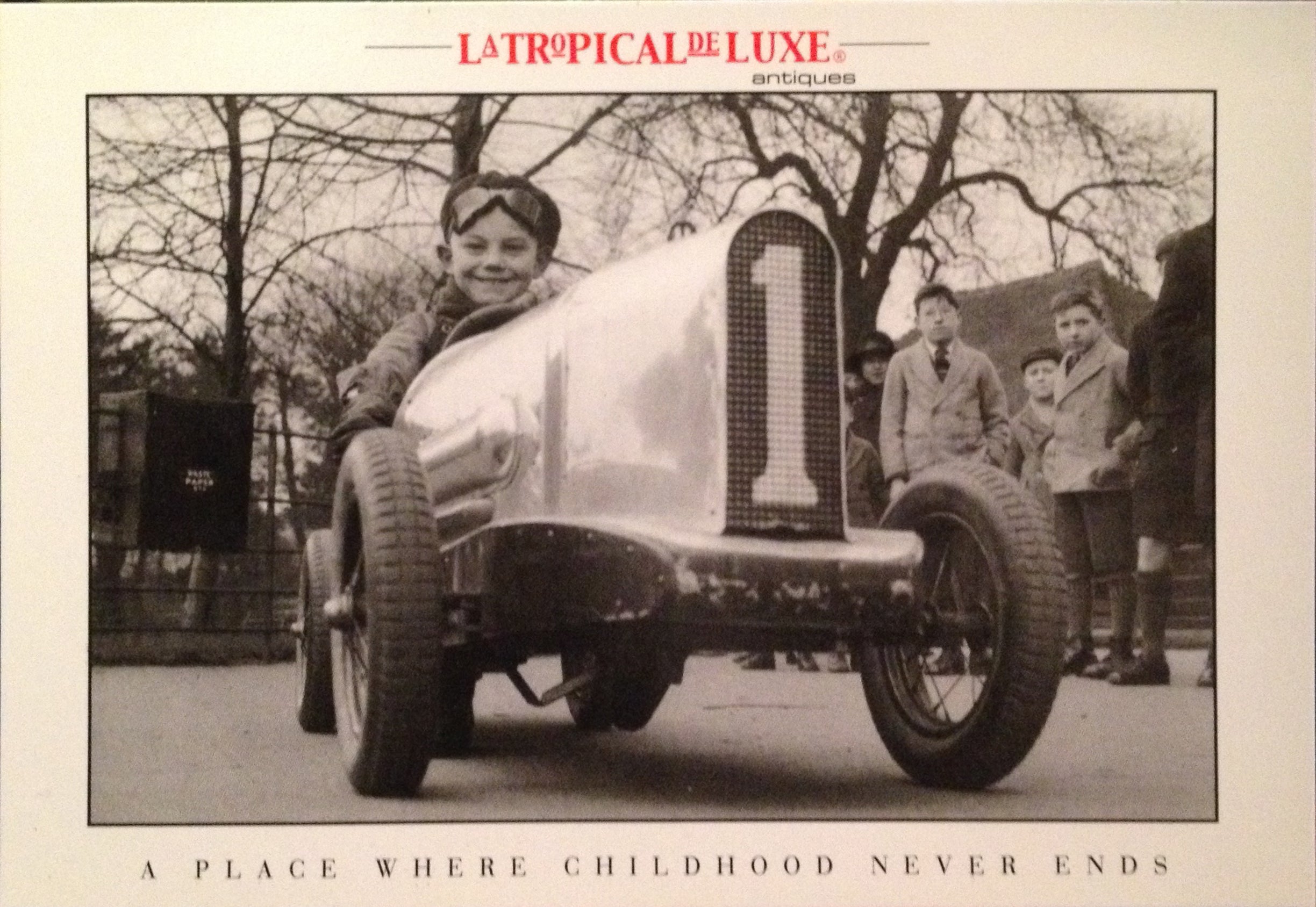
About the Seller
4.9
Vetted Professional Seller
Every seller passes strict standards for authenticity and reliability
Established in 2002
1stDibs seller since 2016
320 sales on 1stDibs
Typical response time: 1 hour
- ShippingRetrieving quote...Shipping from: Buenos Aires, Argentina
- Return Policy
Authenticity Guarantee
In the unlikely event there’s an issue with an item’s authenticity, contact us within 1 year for a full refund. DetailsMoney-Back Guarantee
If your item is not as described, is damaged in transit, or does not arrive, contact us within 7 days for a full refund. Details24-Hour Cancellation
You have a 24-hour grace period in which to reconsider your purchase, with no questions asked.Vetted Professional Sellers
Our world-class sellers must adhere to strict standards for service and quality, maintaining the integrity of our listings.Price-Match Guarantee
If you find that a seller listed the same item for a lower price elsewhere, we’ll match it.Trusted Global Delivery
Our best-in-class carrier network provides specialized shipping options worldwide, including custom delivery.More From This Seller
View All19th Century Bronze Gold-Plated Two-Arm Cherub Figural Candelabras, F. Linke
By François Linke
Located in Buenos Aires, Olivos
Pair of 19th century bronze gold-plated two-arm cherub figural candelabras. F. Linke
Gilt bronze cherubs with two arm candelabras, mounted on white marble pedestal, circled by gilt ...
Category
Antique 19th Century French Belle Époque Candelabras
Materials
Marble, Bronze, Ormolu
Pair of Art Deco Candlesticks Made of Italian Silver, circa 1920s
Located in Buenos Aires, Olivos
Pair of Art Deco candleholder / candlesticks made of Italian silver, circa 1920s.
We have specialized in the sale of Art Deco and Art Nouveau and Vintage styles since 1995. If you h...
Category
Early 20th Century Italian Art Deco Sterling Silver
Materials
Silver
Mid Century Modern, Pair of Table Lamps in style of Paavo Tynell, Finland, 1950s
By Paavo Tynell
Located in Buenos Aires, Olivos
This sculptural pair of table lamps embodies the refined elegance and craftsmanship associated with mid-century Scandinavian design. Made in the 1950s, these lamps feature slim, coni...
Category
Mid-20th Century Finnish Mid-Century Modern Table Lamps
Materials
Brass
Pair of Louis XVI gilt-bronze wall appliques, Pierre Gouthière. , circa 1780
By Pierre Gouthiere
Located in Buenos Aires, Olivos
A pair of Louis XVI gilt-bronze wall appliques, attributed to Pierre Gouthière after a design by Jean-Louis Prieur, circa 1780.
A Louis XVI period pair of delicately chiselled gilt ...
Category
Antique Late 18th Century French Louis XVI Wall Lights and Sconces
Materials
Bronze
$4,875 Sale Price
25% Off
Pair of Art Deco Silver Candleholders with Flower Vase in the Middle
Located in Buenos Aires, Olivos
Pair of Art Deco silver candleholders with flower vase in the middle. Very nice set, in good conditions. Marked 900.
We have specialized in the sale of Art Deco and Art Nouveau and ...
Category
Vintage 1920s German Art Deco Centerpieces
Materials
Silver
Mid-Century / Vintage Brass & Leather Table Lamp, Austria 1950's
By Jacques Adnet, J.T. Kalmar
Located in Buenos Aires, Olivos
Midcentury Brass Tripod table Lamp, Austria, 1950s
A beautiful and solid table lamp, made of brass with a lovely tripod base from the 1950s. This is the model is similar to "Helios"...
Category
Mid-20th Century Austrian Mid-Century Modern Table Lamps
Materials
Brass
You May Also Like
pair of French 19th century Neo-Greek st. Giltwood, Bronze and Ormolu lamps
Located in West Palm Beach, FL
A very elegant and finely detailed pair of French 19th century Neo-Greek st. ebonized Fruitwood, Giltwood, patinated Bronze, and Ormolu lamps. Each stunning lamp is raised by three p...
Category
Antique 19th Century French Greek Revival Table Lamps
Materials
Bronze, Ormolu
Pair of Italian Neoclassical Style Hand-Carved Gilded Wood Table Lamps, ca.1980
Located in Lisse, NL
Wonderful and stylish design pair of table lamps.
This elegant pair of vintage table lamps, crafted in Italy around 1980, showcases exquisite craftsmanship and timeless design. Hand...
Category
20th Century Italian Neoclassical Revival Table Lamps
Materials
Fabric, Wood
$1,257 / set
Free Shipping
19th century Giltwood Converted Candlestick Lamp Pair
Located in Savannah, GA
Classic pair of late 19th century Italian giltwood candlestick lamps featuring much detail and nice old patina. The fluted Corinthian columns sit on tri-shaped plinths with claw feet...
Category
Antique Late 19th Century Italian Neoclassical Table Lamps
Materials
Silk, Giltwood
$1,516 Sale Price / set
20% Off
Pair of Classical 19th Century Gilded Lamps
Located in Brighton, Sussex
A pair of classical gilded ormolu and marble urn lamps, each with scrolling handles and bearded mask mounts.
Category
Antique 19th Century French Classical Greek Table Lamps
Materials
Belgian Black Marble, Ormolu
$3,303 / set
Pair Antique French Gold Bronze Lamps, Circa 1890
Located in New Orleans, LA
Pair Antique French gold bronze lamps, Circa 1890.
Category
Antique Late 19th Century French Table Lamps
Materials
Bronze
pair of Italian 18th century Louis XVI Period Giltwood lamps
Located in West Palm Beach, FL
A lovely and most decorative pair of Italian 18th century Louis XVI Period Giltwood lamps. Each finely carved lamp is raised by a triangular base and supported on three paw feet. The...
Category
Antique 18th Century Italian Louis XVI Table Lamps
Materials
Giltwood
More Ways To Browse
Antique Childrens Table
City Antique Vienna
Antique Spanish Style End Tables
Antique Maple End Table
1923 Table
Antique Large Dining Table And Chairs
Austrian Secession Table
Glass And Brass Dining Table And Chairs
Union Furniture Co
20th Century Italian Baroque Dining Table
Wiener Werkstatte Silver
Antique Union Cases
70s Brass Chairs
Baroque Vienna
American Drew Dining Set Used
Chairs Les Brown Co
Silver Gilt Chair
Old Antique Wooden Chairs
